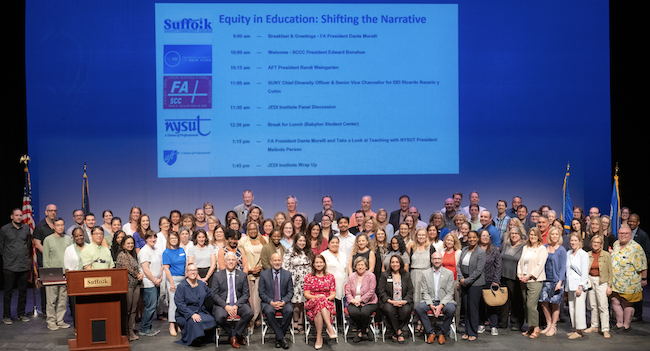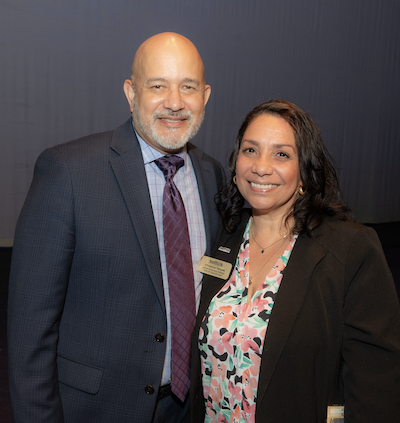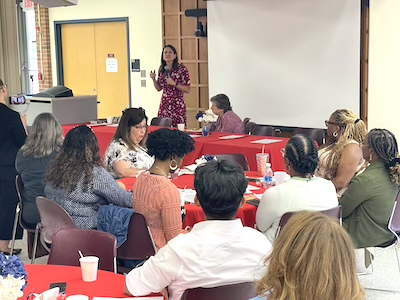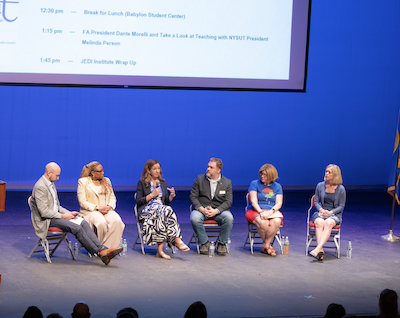Cynthia Eaton
Befitting a SUNY vice chancellor, poet and Marine, Dr. Ricardo Nazario y Colón started with a bit of a vocabulary drill. His point was to remind us that SCCC is part of the State University of New York and that the word university comes to English from the Latin universus (“all people”), while universe comes to English from the Latin universum (“all things”). All people and all things. University and universe come to us from the same root, Dr. Nazario y Colón pointed out, and he noted that the universe is “the widest thing that we can imagine.” Thus, in any university, “we want to be all encompassing,” he continued. Especially at a community college, part of our core purpose is to provide access and opportunity to all. However, Dr. Nazario y Colón cautioned, too many people get caught up in the politicization of diversity, eduity and inclusion (DEI) as terms. “I think it’s critical when we are engaging in the work not to get focused on the word equity but let’s work on outcomes.” Equity is measured in outcomes Faculty across the SUNY system, Dr. Nazario y Colón told us, are committed to DEI work because they recognize that “if we’re going to tap into the best of our humanity” to help our students, “we have to actually do something about it, period.” It’s definitely the doing that matters. As I had mentioned during the symposium panel discussion, we JEDI Institute co-founders periodically hear a bit of push back, with some claiming, “We don’t need this DEI stuff. All of my students are treated equally, and they all have the same opportunity.” If that were absolutely true, however, we should see it reflected at least to some degree in students’ academic outcomes. One specific way our state parent union, NYSUT, is addressing gaps in education is through the Take a Look at Teaching (TALAT) program. For the past few years, the FA has been collaborating with local high schools to bring students to campus to consider becoming future educators. The goal of TALAT is to increase the number of people entering careers in teaching and to improve diversity in the education workforce, and our members Erica Amato and Jared Dowd have been working with Dante on this initiative for us.
NYSUT President Melinda Person spoke about the TALAT program as she led the afternoon discussion about the state of education. In addition, President Person touted the various legislative successes that NYSUT has achieved, including most importantly (especially for over 100 of our SCCC colleagues) steps to Fix Tier 6. The enacted state budget includes the most significant pension reform in 20 years—reducing the final average salary calculation from five to three years for Tier 6 members—which means an average teacher will get bigger pension checks, every month, for life. We are happy to have our state parent union fighting for educators and students in Albany. Other legislative successes focus on K-12 but we know that any improvements there mean better students coming in our doors. These successes include a fix to the Annual Professional Performance Review (APPR) system, social media safety bills to safeguard students’ mental health, a brand new maximum temperature limit to protect kids and teachers in school facilities, reforms to civil service exam updates and adding labor and education members to Industrial Development Agency boards. We are grateful to President Person for joining us on June 10. Nonzero: Equity is not a zero-sum game Dr. Nazario y Colón also directly addressed the phenomenon of people dismissing DEI initiatives on the idea that equity is a zero-sum game. “The narratives across the country are these zero-sum narrative discussions that somehow someone is being cheated, that it is not fair, that it is not equal. [But] we’re not talking about equality, we’re talking about equity,” he noted. Further, he said,
It is time to move beyond the sink-or-swim mentality. We cannot afford to keep the same old practices and believe, well, students either get it or they don’t—and that’s none of our concern. Equity in students’ academic outcomes is absolutely our concern. AFT President Randi Weingarten was very clear on this point as well. “In talking about diversity and equity... it’s been weaponized to be a division instead of understanding that diversity in this country is our strength. Diversity is a way that we bring people together and we lift all boats, [but] what happens unfortunately is some people say, ‘if I get something that means someone else doesn’t,’ and I reject that.” Revising our pedagogy to be more inclusive or providing additional resources to better help more students succeed is not about giving “unfair” advantages to some or about the “soft bigotry of low expectations.” It is simply a gesture of understanding that our student demographics are changing and thus we should modify our practices to better meet the needs of the students who are before us. Reaching today’s SCCC students President Bonahue addressed how this plays out at SCCC. He noted that equity is part of a national conversation and since about half of all undergraduates in the SUNY system are enrolled in community colleges, it matters deeply given the demographic changes on Long Island and at our college. Because we are seeing such changes in our classrooms and workspaces, Dr. Bonahue explained, understanding equity “is critical if we as professionals are to truly support students, regardless of their background, and to make every student successful.” Dr. Bonahue’s remarks were aligned with those of Dr. Nazario y Colón and President Weingarten. In all of our work with students, he said, we need to “design with intention a college experience that doesn’t wait for students to ask for help—but that proactively ensures that the college is ready to assist all students who want to learn.” The college administration is taking steps such as implementation of early alerts, revising the model for scholarships and financial support, incorporating wraparound services, and addressing students’ basic needs. During the panel discussion, several colleagues shared specific, concrete ways that they have worked to make their work more “JEDI,” that is, more just, equitable, diverse and inclusive. I presented first, by sharing how I had collaborated with colleagues to create our JEDI syllabi for each course modality, which are designed to be more student friendly and accessible for students who might be first generation. In the spring, I shared those as pre-packaged Brightspace modules for anyone at the college to download, modify and use in their own Brightspace class websites. I also made a student resources module available to all colleagues as another way to help students find what they need to succeed. Tom Flesher, assistant professor of economics, started by indicating, “I tell people that the misconceptions that they have about justice, diversity, equity and inclusion being about changing our standards are incorrect.” Being in the JEDI Institute, he realized it’s best to “find the smallest effective changes that I can make and then expand on them year after year.” One technique he uses is simply to pause during a lecture presentation to ask students how well they comprehend the material by giving him a thumbs up, thumbs down or thumbs in the middle. It’s an easy, quick, effective way for him to see whether he needs to slow down and reiterate a specific topic without calling on individual students to speak up.
Lauren Liburd shared how, as an adjunct assistant professor of business, she started to open up conversations in the classroom about what it’s like to be one of the few women of color in business. “I found my students were so open to that and they could relate to it,” she noted. “I primarily teach asynchronously… and one of the first responses I have for my introduction video for my courses, a young woman sent me a message, ‘I’ve never seen a black woman in business before; the only other person I know is my aunt who owns a small business.’” Lauren talked about encouraging the student to share her experiences and added, “There is no experience that’s not valuable and cannot contribute to the conversation that we’re having in our classroom.” Jen Forni, college director of disability services, explained that she comes at the work from a different angle because she is not in the classroom. However, she works daily in partnership with classroom faculty by reading students’ documentation and trying to determine accommodations, asking what is equitable and what is reasonable. Collaborating with individual faculty is critical, Jen shared, “to find what the answers are for our students and how we can make any course appropriate for a student with a different type of disability… and how we make those things work and adhere to the same standards that are going on in the various classrooms.” Again, as Jen noted, the goal is not to lower or dilute our academic standards but rather to figure out what supports are needed by each student to meet the standards of a given class. This is how we work to improve all students’ academic outcomes, regardless of their background. This is how we practice equity. Then, as President Weingarten argued, “It doesn’t matter whether you were born to wealth or not born to wealth, whether you were born to resources or not born to resources.” In our position at a community college, she noted, “we are part of an arc that essentially asks what can we do in the education space to help prepare young people… for opportunity, for life, for career, for college—and in a way that we level the playing field so that anyone in America could have that opportunity.” These kinds of conversations about equity are a “wonderful example,” noted FA President Dante Morelli, “of what can happen in higher ed when you bring people together. We are better together because we collaborate together.” Learn more about the good work we are doing in the JEDI Institute to try to improve all all students’ academic outcomes and check out our JEDI Colleagues Share page. We would love to hear your ideas if you are willing to contribute to that page as well. Email me if you would like to do so. |





